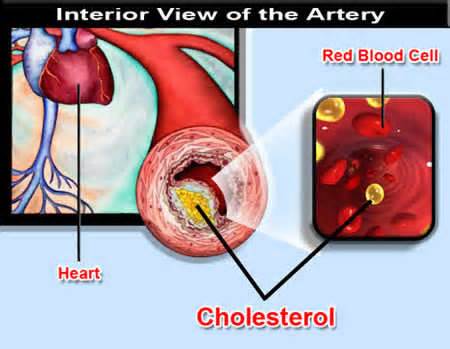
- posted: Mar. 03, 2016
THE CHOLESTEROL MYTH
by Dr. Jon Repole, D.C., N.C., H.H.P., C.P.T.
The Department of Health and Human Services along with the Department of Agriculture issues the, “Dietary Guidelines for Americans,” every five years. This federal publication serves as the foundation for  policy change, food manufacturer’s claims, and, of course, influences how and what we eat. This year there is considerable controversy surrounding the non-essential nutrient referred to as cholesterol. Our trusted decision makers are poised to overturn previously held warnings about cholesterol intake which stated, “cholesterol intake be limited to no more than 300 mg/day” in favor of, “cholesterol is not a nutrient of concern for overconsumption.”
policy change, food manufacturer’s claims, and, of course, influences how and what we eat. This year there is considerable controversy surrounding the non-essential nutrient referred to as cholesterol. Our trusted decision makers are poised to overturn previously held warnings about cholesterol intake which stated, “cholesterol intake be limited to no more than 300 mg/day” in favor of, “cholesterol is not a nutrient of concern for overconsumption.”
How can this be?
To start with, cholesterol has been associated for decades with cardiovascular health. Higher levels indicated increased risk and lower levels decreased risk. This is, of course, an immature way of assessing heart health/risk status considering the compiling evidence of heart disease with the following contributing etiologies (which is beyond the scope of this blog post) such as:
- Decreased nutrient status (folic acid, omega-3 fatty acids, Vitamin D, etc.)
- Decreased whole plant-based foods
- Increased animal Products
- Lifestyle diseases such as obesity, cancer and diabetes type-2
- Sedentary lifestyle
- Stress
- Hormonal dysfunction (estrogen, progesterone, testosterone, cortisol, etc.)
- Infections
- Inflammation
- Gut dysbiosis
Although cholesterol status is too simplistic a tool to assess our overall heart health it is, I argue, a great indicator for America’s veracious appetite for animal flesh and secretions (i.e. dairy products). Blood cholesterol levels, therefore, can offer us a great snapshot in assessing someone’s carnivorous tendencies. If viewed in this light, a different story will emerge. These meat-centered tendencies are, in fact, correlated not only with heart health but with every other degenerative and lifestyle disease.
If the previously held warnings about cholesterol are overturned, the new, “Dietary Guidelines for Americans,” will make, I believe, one of the most confusing and schizophrenic recommendations which will be found rooted in the following two statements:
- “less than 10% of calories should come from saturated fat”
- “cholesterol is not a nutrient of concern for overconsumption”
So why do I say this?
To start with, if you were to ask the average person how they can take the above statements and translate them into practical everyday advice, I believe, they would be very confused.
And for very good reasons!
Cholesterol is found ONLY in the animal kingdom via animal flesh and secretions. Saturated fat is found primarily in the animal kingdom with very few exceptions in the plant kingdom – coconut and palm. (Note: the saturated fat contained in coconut and palm have been found in a multitude of studies to be cardio-protective)
But to connect the dots even more – cholesterol is found alongside foods WITH saturated fats. Thus, if you eat saturated fat, you eat cholesterol and vice versa.NO fruit, vegetable, whole grain, nut or seed contains cholesterol or saturated fats (exceptions noted above) in any significant amounts.
If the statements are approved, the true nature of the advisory board’s recommendations will go on to be misinterpreted and disguised. This has been the story for some time now as it should come as know surprise that the Dairy and Beef Industry have fought long and hard since the 1980’s not to have the phrase “lower cholesterol and saturated fat” be replaced with the phrase “lower animal products.”
From a practical perspective, lowering cholesterol and saturated fat simply means:
- decrease ANIMAL FLESH AND SECRETION – PERIOD!
So let’s ask the Dietary Committee to change the verbiage to make this easy for the American public to understand!
The advisory board also states that cholesterol blood levels really do not influence dietary intake and that  lower cholesterol levels are not associated with “disease” risk. They are basing this on, I believe, statin medication usage and current dietary recommendations and trends. This, of course, is not the whole story.
lower cholesterol levels are not associated with “disease” risk. They are basing this on, I believe, statin medication usage and current dietary recommendations and trends. This, of course, is not the whole story.
Let me explain.
Most people had believed that their choice to eat chicken over red meat would help them decrease their levels of cholesterol. This is what their physicians had told them – go on a chicken diet. Surprise…Surprise…When they went back to have their levels of cholesterol checked – nothing changed. Why? A regular serving of chicken comes packed with 85 mg of cholesterol per serving while red meat and the like contain 86 mg. The answer to decrease cholesterol levels would be, of course, to eliminate both the red meat and the chicken along with all animal products and secretions. In fact, ask any physician who encourages a whole food plant-based diet whether they see dramatic changes in their patient’s blood work (decreased cholesterol levels) and they will most certainly say – YES. Over the past 15 years, this has certainly been my experience, as well. This is NOT to say that every single person’s cholesterol will drop dramatically simply because there are some “genetic” individual factors that must be accounted for, as well.
Furthermore, to add even more confusion some have even jumped on the “paleo” dietary recommendations – which to be fair has improved people’s overall health status simply because any diet that moves people away from processed foods to more whole foods will be advantageous when compared to the standard America diet. This will, of course, change someone’s health for the better without changing their cholesterol levels. But the point here is that overlooking the above facts will draw erroneous conclusions as we are searching for the optimal human diet for the 21st century that will provide sustainability, optimal health, environmental protection, and the gift of compassion to all sentient beings.
In regards to blood work - it is important to point out that reference ranges are determined, in large part, from diseased persons. Thus, reference ranges (used in conventional medicine) do not equate to optimal ranges (used in functional and holistic practices). This is an extremely important consideration simply because as a holistic practitioner, I am involved in wellness and prevention rather than disease and symptom-based care. If I wanted to give my patient a prescription for heart disease, diabetes, cancer, etc. - I would simply ask them to follow the same dietary patterns they are engaging in – the standard America diet. Our current conventional wisdom is a cholesterol level below 200. This represents the majority and average cholesterol for Americans! This obviously is not a reference range representative of wellness. Around the globe we see varying average ranges for cholesterol. As an example, in rural China, the United State’s reference range low is their average reference range high. Why is this important? Because in rural China, diseases of affluence (heart disease, cancer, and diabetes, to name a few) are alarming “non-existent” or strikingly lower!
In regards to statin usage and it’s efficacy (statin medications are used to lower cholesterol). Common sense dictates the following:
If you earn your low cholesterol through a diet of fruit, vegetables, healthy legumes, grains, nuts and seeds – you are following a diet that has a proven track record for cardioprotection, decreased cancer rates, decreased diabetes and increased longevity and aging. You cannot EARN your low cholesterol through statin drug usage!
If we look at pockets of longevity (quantity of years) and positive aging (quality of years) in remote areas around the globe we will see some undeniable and important similarities: strong family values, hard work ethic, physical labor, and a predominately plant based diet (whereby cholesterol can become a good biomarker).
Moving on in our discussion…
Cholesterol is a non essential nutrient that is produced is sufficient amounts within the body. Cholesterol, of course, is a vital nutrient for inclusion in cell membrane walls, precursors to hormone synthesis, etc. However, if our body is functioning optimally – then our physiology will make all the cholesterol that is needed for optimal functioning. In the case of disease processes (liver dysfunction, etc.) – exogenous intake of cholesterol could be considered as a medicinal remedy. But this would be similar to equating all vital, but non-essential nutrients for our body like pancreatic enzymes, bile, etc.
Therefore, the statement, “cholesterol is not a nutrient of concern for overconsumption” should read, “cholesterol is not an essential nutrient and overconsumption is of major concern.”
An even stronger point, however, is the fact that almost ALL (99%) of potentially ingested cholesterol will come from disease-laden factory farmed animals. We can say this because 99% of all animal products sold in supermarkets, restaurants, grocery stores, etc. come from factory farms – a very important point that the “Paleo” community overlooks. Furthermore, we live in a different time – we have choices today – where sustainability for future generations is a must. In some ways, our “cholesterol status” indirectly influences our environmental footprint, as well.
With that said, how can we say that, “cholesterol is not a nutrient of concern for overconsumption?”
In conclusion, here are some key points:
- Cholesterol and the lipid panel should be used to quickly assess carnivorous habits in non-genetically responsive individuals.
- Cholesterol and the lipid panel are ONE of many biomarkers that must be assessed such as: weight, exercise status, inflammatory markers, nutrient status, etc.
- Ingestion of cholesterol is not essential for the human body.
- The words saturated fats and cholesterol should be replaced with simple verbiage such as: ANIMAL PRODUCTS!
- Cholesterol is simply a representation of a more serious issue simply because ALL foods that contain cholesterol have the following characteristics:
- High levels of animal protein.
- The highest levels of micro-organism (BUGS) when compared to plant-based foods which directly relates to an increased inflammatory load in the body’s GI system and systemic circulation.
- Come packed with other anti-nutrients such as bGH and antibiotics.
- No fiber content.
- And much more!
Locations
Jacksonville Location
9957 Moorings Drive, Suite 403
Jacksonville, FL 32257, US
HOURS OF OPERATION
9:00 am - 6:00 pm
9:00 am - 6:00 pm
9:00 am - 6:00 pm
9:00 am - 6:00 pm
9:00 am - 6:00 pm
Closed
Closed

